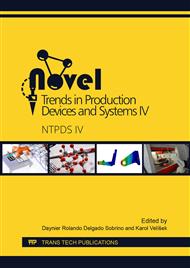p.299
p.307
p.315
p.327
p.335
p.345
p.354
p.362
p.370
Impact of Applied Anti-Reflective Material on Accuracy of Optical 3D Digitisation
Abstract:
Using optical 3D digitisation for dimensional and shape inspection of work-pieces became a trend recently. Before a 3D scanning process starts, surface of the measured part must usually be coated with a thin layer of anti-reflective material. Such surface coating can be performed by means of a wide range of products with various composition and application method. It is however important to know how the matt coating affects the quality and accuracy of digitization, what the structure and thickness of a coating are. The thickness of a coating may vary significantly from product to product and according to our research, it ranges between units and hundreds of µm. This article presents results of an extensive research of seven matt coating products commonly used in practice. The measurement was carried out on cylindrical and spherical elements using ATOS optical 3D scanner and an electron microscope. Thereafter, the measurement results were analysed to define how the applied coating product along with the material of measured object affect the work-piece dimensional properties. The ease of coating removal was evaluated in the research as well.
Info:
Periodical:
Pages:
335-344
Citation:
Online since:
April 2018
Authors:
Price:
Сopyright:
© 2018 Trans Tech Publications Ltd. All Rights Reserved
Share:
Citation:


